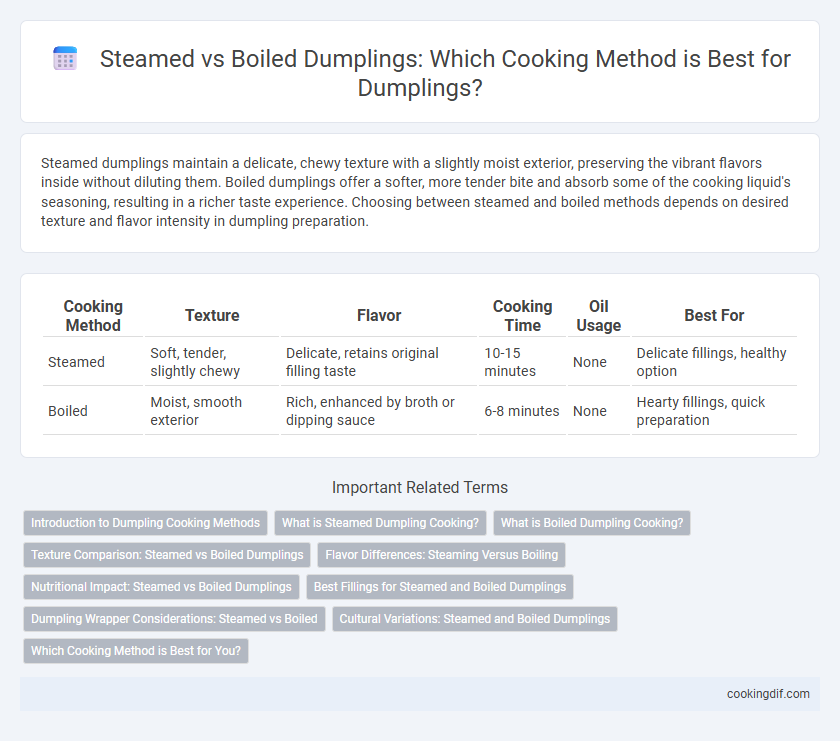Steamed dumplings maintain a delicate, chewy texture with a slightly moist exterior, preserving the vibrant flavors inside without diluting them. Boiled dumplings offer a softer, more tender bite and absorb some of the cooking liquid's seasoning, resulting in a richer taste experience. Choosing between steamed and boiled methods depends on desired texture and flavor intensity in dumpling preparation.
Table of Comparison
| Cooking Method | Texture | Flavor | Cooking Time | Oil Usage | Best For |
|---|---|---|---|---|---|
| Steamed | Soft, tender, slightly chewy | Delicate, retains original filling taste | 10-15 minutes | None | Delicate fillings, healthy option |
| Boiled | Moist, smooth exterior | Rich, enhanced by broth or dipping sauce | 6-8 minutes | None | Hearty fillings, quick preparation |
Introduction to Dumpling Cooking Methods
Steamed and boiled are two popular dumpling cooking methods, each affecting texture and flavor. Steaming preserves the dumpling's delicate skin, resulting in a chewy and moist consistency, while boiling produces a softer, more tender dumpling often with a slightly diluted filling taste. Choosing between these methods depends on the dumpling type and desired culinary experience.
What is Steamed Dumpling Cooking?
Steamed dumpling cooking involves placing dumplings in a bamboo or metal steamer basket suspended over boiling water, allowing the steam to cook the dough wrapper and fillings gently. This method preserves the dumpling's delicate texture, ensuring a tender yet slightly chewy exterior with moist, flavorful fillings. Steaming is preferred for dumplings like Chinese xiao long bao, where the steaming process locks in juices and prevents drying out.
What is Boiled Dumpling Cooking?
Boiled dumpling cooking involves submerging the dumplings in boiling water until they float to the surface, indicating they are cooked through and have a tender, juicy texture. This method ensures even cooking and helps retain the dumpling's filling moisture, making them soft and flavorful. Unlike steaming, boiling allows water to penetrate the dough slightly, resulting in a smooth, chewy outer skin.
Texture Comparison: Steamed vs Boiled Dumplings
Steamed dumplings maintain a tender yet slightly chewy texture with a smooth, glossy skin that holds fillings firmly without becoming soggy. Boiled dumplings often have a softer, more delicate exterior that can absorb some water, resulting in a plumper, juicier bite but a less distinct dough texture. Texture preference depends on the desired balance between firmness and moistness, with steaming favored for a more elastic bite and boiling preferred for a melt-in-the-mouth experience.
Flavor Differences: Steaming Versus Boiling
Steaming dumplings preserves the delicate texture and enhances the natural flavors of fillings by gently cooking without direct water contact, resulting in a tender, slightly chewy wrapper. Boiling dumplings absorb more moisture, which can dilute some flavors but yields a softer, more gelatinous texture in the dough. Flavor intensity tends to be stronger in steamed dumplings due to less leaching of juices, while boiled dumplings offer a more subtle, homogenous taste profile.
Nutritional Impact: Steamed vs Boiled Dumplings
Steamed dumplings retain more vitamins and minerals due to minimal nutrient loss in cooking water, preserving water-soluble nutrients like B vitamins and vitamin C. Boiled dumplings may lose some nutrients to the cooking water, but this method can reduce fat content by allowing excess oil to drain. Both methods produce low-fat, nutrient-rich dishes, with steaming offering a slight advantage in maintaining nutritional value.
Best Fillings for Steamed and Boiled Dumplings
Steamed dumplings are ideal for delicate fillings such as shrimp, garlic chives, and tofu because the gentle cooking preserves moisture and soft textures. Boiled dumplings work best with dense or hearty fillings like pork, cabbage, and Chinese chives, as the boiling process intensifies flavors and ensures thorough cooking. Selecting the right filling for each method enhances the overall dumpling experience by balancing texture and taste.
Dumpling Wrapper Considerations: Steamed vs Boiled
Steamed dumplings preserve the delicate texture and translucency of thin wrappers by gently cooking with moist heat, which prevents them from becoming overly saturated or soggy. Boiling requires thicker, more robust wrappers to withstand the direct contact with water without breaking apart or losing structural integrity. Choosing the appropriate dumpling wrapper thickness and composition is crucial to achieving optimal texture and taste based on the cooking method.
Cultural Variations: Steamed and Boiled Dumplings
Steamed dumplings are a staple in Northern Chinese cuisine, prized for their soft, chewy texture that preserves the delicate flavors of the filling. Boiled dumplings, often associated with Eastern European traditions like Russian pelmeni or Polish pierogi, are celebrated for their tender skins and hearty, warm fillings. Variations in steaming and boiling techniques reflect regional ingredients and cultural preferences, highlighting the rich diversity of dumpling preparation worldwide.
Which Cooking Method is Best for You?
Steaming dumplings preserves their delicate texture and enhances the natural flavors, making it ideal for those seeking a light and tender bite. Boiling provides a softer, chewier texture and usually results in a more flavorful broth, perfect for dumpling soups or heartier meals. The best cooking method depends on your texture preference and the dish you want to create--choose steaming for a refined experience or boiling for a comforting, soup-based option.
Steamed vs boiled for dumpling cooking method Infographic

 cookingdif.com
cookingdif.com